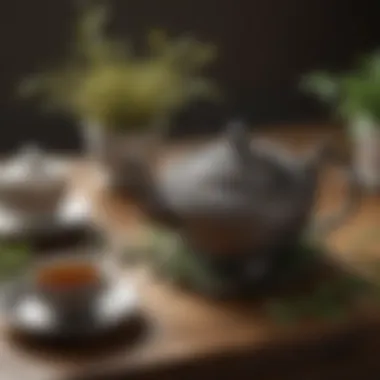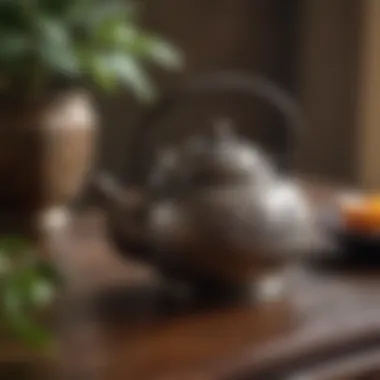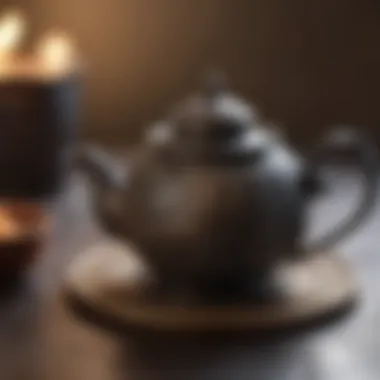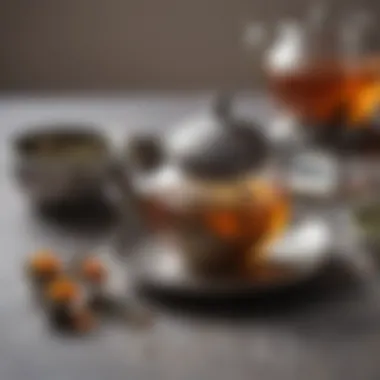The Elegance of Small Metal Tea Pots


Intro
Small metal tea pots have a rich history that blends functionality with artistry. They are not just vessels for brewing tea; they symbolize culture, tradition, and craftsmanship across various societies. From the intricate designs of Chinese Yixing teapots to the minimalist aesthetics of Japanese tetsubin, every small metal tea pot tells a story.
In this exploration, we will investigate the significance of these tea pots through different lenses: their historical context, crafting techniques, materials used, and their role in both everyday life and ceremonial occasions. Understanding small metal tea pots goes beyond appreciating their beauty. It encompasses an appreciation for their practicality and the cultural meanings they convey.
As we dive deeper, keywords such as "tea pot history," "tea pot materials," and "cultural significance of tea pots" will be explored to enhance our understanding and visibility in searched queries. This narrative presents insights tailored for both tea enthusiasts and collectors, enriching their knowledge about the allure of small metal tea pots.
Prelims to Small Metal Tea Pots
This section provides insights into small metal tea pots, exploring their significance, form, and function. In the world of tea, the small metal tea pot is not merely a vessel for brewing; it embodies a blend of artistry, tradition, and practical utility. Understanding the essence of small metal tea pots paves the way for appreciating their role in both domestic and ceremonial settings.
Definition and Purpose
A small metal tea pot is typically a compact vessel made from various metals designed for brewing and serving tea. Unlike larger counterparts, these pots cater to smaller quantities, making them ideal for intimate gatherings or personal use. Their purpose transcends mere functionality; it encapsulates the art of tea preparation, inviting both ritual and enjoyment into the daily experience of drinking tea. Small metal tea pots serve as a gateway to savoring diverse tea types, revealing different flavors and aromas, while providing efficient heat retention during the brewing process.
Historical Overview
The history of small metal tea pots reflects cultural evolutions as much as it does technological advancements. Metal tea pots have existed for centuries, with roots traceable to various ancient civilizations. Their design and material evolved based on regional preferences and available resources. In places like Japan, the cast iron tea pot known as tetsubin became iconic, while in Europe, stainless steel pots emerged as a symbol of modernity and practicality. Each era contributed to the refinement of these vessels, showcasing craftsmanship that blends functionality and aesthetic appeal.
Cultural Significance
Small metal tea pots hold cultural importance across different societies. They are often crafted with intricate designs that reflect local traditions. In England, the metal tea pot became a staple during the afternoon tea ritual, representing social status and hospitality. Meanwhile, in Chinese culture, metal pots are used during gongfu tea ceremonies, highlighting the meticulous approach to tea brewing. These pots often symbolize community, shared experiences, and the meticulous care involved in preparing tea. The significance of these vessels extends beyond their physical form, embodying deep-rooted social customs and memorable moments.
Materials Used in Small Metal Tea Pots
The choice of materials used in small metal tea pots is pivotal. Each material offers distinct advantages and disadvantages, impacting both functionality and aesthetic appeal. Understanding these materials is essential for tea enthusiasts and collectors. Selecting the right material can enhance the tea brewing experience while also considering durability and ease of maintenance.
Stainless Steel
Stainless steel is a popular option for small metal tea pots. It is renowned for its durability and resistance to rust and corrosion. This material is non-reactive, meaning it won't alter the flavor of the tea, making it ideal for purists. The sleek design of stainless steel tea pots also adds a modern touch to any kitchen or tea set.
Another benefit is ease of cleaning. Stainless steel tea pots are often dishwasher safe, which is a major convenience for daily use. However, they can lose heat quickly if they are thin-walled. Therefore, it is important to choose a model with sufficient insulation if heat retention is a primary concern.
Aluminum
Aluminum tea pots are lightweight and generally less expensive than those made from stainless steel or cast iron. This makes them a practical choice for those who prefer portability. Additionally, aluminum has excellent heat conductivity, which allows the water to heat up quickly.
However, one downside is that aluminum can react with acidic components in some teas if not coated properly. Many modern aluminum pots resolve this issue by using a non-reactive coating. Overall, aluminum can be a suitable option for casual tea drinkers looking for a balance between price and performance.
Copper
Copper tea pots offer a unique aesthetic and are known for their excellent thermal conductivity. This material heats up rapidly and evenly, making it effective for preparing tea. The ability to control temperature precisely is a key benefit for those who value the brewing process.
On the downside, copper requires more maintenance. It can tarnish and may need polishing to maintain its shine. Additionally, copper is reactive with certain foods and beverages unless lined with another material, such as stainless steel. For users who appreciate beauty and precision, copper tea pots can be a beautiful and functional choice.
Cast Iron
Cast iron tea pots, or tetsubin, are traditionally used in Japanese tea ceremonies. These pots are celebrated for their exceptional heat retention. Once heated, they keep the tea warm for extended periods, making them ideal for leisurely tea sessions.
Moreover, cast iron pots often come with enamel coatings, which not only prevent rust but also add to their visual appeal. However, they can be heavy and might require careful handling. Their durability is an advantage, but they may also demand more maintenance compared to lighter materials.
In summary, the choice of material in small metal tea pots is crucial. Each material has specific benefits and potential shortcomings that can affect tea preparation and enjoyment. By weighing these factors, individuals can make informed decisions that suit their tea-drinking habits and preferences.


Design Aspects of Small Metal Tea Pots
The design aspects of small metal tea pots are integral for both aesthetic appeal and functional performance. An appealing design enhances user experience and often reflects cultural values and craftsmanship. When considering a small metal tea pot, several elements come into play, including traditional designs, modern interpretations, and ergonomic considerations. Each of these facets contributes significantly to the overall utility and enjoyment of the product.
Traditional Designs
Traditional designs of small metal tea pots are steeped in history and often embody distinct cultural narratives. Many of these teapots showcase intricate patterns and motifs that reflect the craftsmanship of a particular region. For instance, Japanese Tetsubin, made of cast iron, displays beautiful designs that are both decorative and functional, offering excellent heat retention. Similarly, Moroccan tea pots often feature ornamental engravings and are typically used in elaborate tea rituals.
Traditional designs are not merely aesthetic; they often serve practical purposes. For example, the shapes of spouts can affect pouring efficiency, impacting how tea is enjoyed. When selecting a traditional small metal tea pot, it’s important to understand the context and cultural significance behind its design.
Modern Interpretations
Modern interpretations of small metal tea pots often merge functionality with innovative aesthetics. Today, many designers experiment with forms and materials, resulting in teapots that can serve as statement pieces in kitchen decor. Materials like stainless steel and aluminum are frequently used in contemporary designs. They offer a minimalist aesthetic, often featuring sleek lines and bold colors.
Furthermore, modern designs may include features such as built-in infusers or insulated bodies. These additions aim to improve the user experience by providing convenience and better heat retention. Consumers today appreciate the blend of style and practicality, making modern teapots popular choices.
Ergonomic Considerations
Ergonomic considerations are crucial when evaluating small metal tea pots. The handle's shape and placement can significantly affect how comfortable a teapot is to use. A well-designed handle allows for a secure grip, reducing the likelihood of spills and ensuring easy pouring. Additionally, the weight of the teapot is also an essential factor. A lighter teapot may be easier to handle but could sacrifice stability, while a heavier one can provide a sense of sturdiness.
Incorporating ergonomic features is also about accessibility. For individuals with limited mobility, the design should facilitate an enjoyable experience without causing strain. When choosing a small metal tea pot, it's wise to consider how ergonomic aspects affect your daily use.
Modern design must not only look good but also serve the practical needs of its users.
Functional Considerations
The functional considerations of small metal tea pots are critical to understanding their role in both everyday use and ceremonial contexts. When selecting a tea pot, aspects such as heat retention, size and capacity, and ease of use and maintenance must be considered. These elements are not only about utility but also enhance the overall tea drinking experience.
Heat Retention
Heat retention is one of the most important features of a small metal tea pot. Different materials exhibit varying capacities for maintaining heat. For instance, cast iron tea pots are particularly well-known for their superior heat retention. They can keep tea warm for an extended period, which is beneficial during lengthy tea sessions. On the other hand, stainless steel may not retain heat as effectively but offers advantages in durability and resistance to rust.
When choosing a small metal tea pot, evaluate how long you typically enjoy your tea. If you prefer to sip at leisure, opting for a pot that retains heat well is advisable. Additionally, consider how heat retention can affect the flavor of the tea. An ability to maintain warmth allows the flavors to develop fully, providing a richer experience.
Size and Capacity
Size and capacity are essential considerations for any tea lover. A small metal tea pot's size will determine how much tea can be brewed at once. For personal use, a capacity of 16 to 24 ounces is often sufficient. Such a size allows for multiple servings while not taking up much space. However, if entertaining guests, consider larger options that can hold around 32 ounces or more.
Additionally, the pot's design can also influence its size. A wider base may hold more tea while maintaining a compact height. Assess your usual serving habits and how often you treat guests to tea. Based on that, match the size of the pot to your lifestyle needs and preferences.
Ease of Use and Maintenance
Ease of use and maintenance should never be overlooked when it comes to small metal tea pots. A well-designed pot allows for smooth pouring and easy filling. Look for pots with comfortable handles and spouts that direct the flow efficiently. This aspect contributes significantly to the overall enjoyment of serving tea.
In terms of maintenance, consider the cleaning aspects of the materials used. Stainless steel pots generally require minimal effort to keep clean compared to copper ones, which may tarnish over time. Regular maintenance, such as washing with mild soap and avoiding abrasive materials, can extend the life of your tea pot.
Choosing a tea pot that balances usability with low maintenance can significantly enhance your tea drinking experience.
Ultimately, understanding these functional considerations will help any tea enthusiast make an informed decision. A well-selected small metal tea pot not only serves its practical purpose but also enriches the ritual of tea drinking.
Uses of Small Metal Tea Pots
Small metal tea pots serve a range of purposes in different contexts. Their uses extend beyond simple brewing to encompass cultural rituals, personal preferences, and aesthetic choices. Understanding these uses is essential for anyone interested in tea culture. This section details several significant aspects of small metal tea pots, emphasizing their roles in everyday life, ceremonial occasions, and collecting as well as gifting.


Everyday Use
In the realm of everyday tea drinking, small metal tea pots are highly valued for their practicality. Made from materials like stainless steel and cast iron, these tea pots offer durability and heat retention. Many tea enthusiasts enjoy using these pots for daily brews due to their ability to quickly reach steeping temperatures.
Using a small metal tea pot in daily life has numerous advantages:
- Efficiency: The metal conducts heat well, allowing for faster brewing.
- Durability: Compared to ceramic, metal pots are less likely to break or chip.
- Ease of Maintenance: Most small metal tea pots are easy to clean and maintain, ensuring longevity in daily use.
Additionally, these tea pots can complement modern kitchens and tea-goers with their sleek designs and ability to match various decor styles. Overall, the everyday use of small metal tea pots speaks to their functional nature and adaptability.
Ceremonial Uses
Ceremonies often hold deep significance, and small metal tea pots can play a central role in these rituals. Various cultures utilize specific pots to enhance traditional tea ceremonies. These pots not only convey warmth but also serve to build connections among participants. In many Asian cultures, tea serves as a symbol of hospitality, respect, and unity. Thus, metal tea pots are commonly used in formal tea ceremonies.
Key aspects of ceremonial uses include:
- Symbolism: Tea pots are not merely tools; they represent community and cultural heritage.
- Craftsmanship: Many ceremonial pots feature intricate designs and craftsmanship, elevating their status.
- Participatory Experience: Using a metal tea pot during ceremonies adds a tangible element, enriching the experience for everyone involved.
Through the lens of ceremonies, small metal tea pots emerge as not only functional items but also as significant cultural artifacts that help preserve traditions.
Gifting and Collecting
The beauty and craftsmanship of small metal tea pots make them ideal gifts and collectibles. These items are often appreciated for their aesthetic value and practicality. Gifting a metal tea pot can symbolize various sentiments, such as friendship, gratitude, or celebration. Recipients often value these thoughtful presents not just for their utility but also for the stories and memories they may hold.
Collecting tea pots has become a beloved hobby among enthusiasts. Some prioritize historical significance, while others focus on specific styles or materials. Here are several reasons why collectors pursue small metal tea pots:
- Variety: The wide range of designs and styles creates numerous options for collectors.
- Personal Connection: Each pot can tell a story or reflect personal tastes and preferences.
- Value Appreciation: Some antique or limited-edition models can increase in value over time.
Choosing the Right Small Metal Tea Pot
Choosing the right small metal tea pot plays a significant role in enhancing both the tea-drinking experience and the aesthetic appeal of one's kitchen or dining area. With the variety of materials, designs, and functionalities available, making an informed decision can elevate the quality of tea preparation. Selecting a tea pot that aligns with your preferences not only optimizes the preparation process but also reflects personal style and values.
Assessing Quality
Quality is fundamental when it comes to metal tea pots. The durability and functionality often depend on the material used and the craftsmanship involved. To assess quality, consider the following factors:
- Material Integrity: Look for pots made from high-grade materials, such as stainless steel or cast iron. These materials ensure longevity and do not impart unwanted flavors to your tea.
- Construction: Examine the welds and joints. A well-constructed pot will have smooth seams, ensuring there are no leaks.
- Brand Reputation: Research the brands and their history. Established brands often guarantee better quality due to their experience and commitment to craftsmanship.
By paying attention to these details, you can select a tea pot that will serve you well for years.
Price Considerations
The price of small metal tea pots can vary greatly based on factors such as material and design complexity. It is essential to establish a budget before beginning your search.
- Price Range: Entry-level pots can be found at lower prices but may lack design and durability. Mid-range options often provide a balance of quality and value, while high-end pots can be masterpieces reflecting craftsmanship.
- Investment vs. Ordinary Purchase: Consider whether you are purchasing the tea pot as a functional item or as an investment piece. A higher price may justify a unique design or artisanal quality.
- Sales and Discounts: Keep an eye out for seasonal sales or promotions that can make high-quality pots more affordable.
Understanding these aspects will help in making a financially sound decision without compromising quality.
Personal Style Preferences
Personal style is crucial when choosing a small metal tea pot. The pot should align with your aesthetic preferences and complement your home decor. Here are a few aspects to contemplate:
- Design and Finish: Select a design that attracts you. Whether it is traditional, modern, or something in between, the visual appeal should resonate with your taste.
- Size and Capacity: Ensure the pot size fits your needs. If you often brew for guests, a larger capacity may be necessary, while a smaller pot may suffice for personal use.
- Color Palette: The color of the tea pot should harmonize with your kitchen or dining area. Metallic finishes offer a contemporary look, while enamel-coated options can add a splash of color.


Taking these personal elements into account will lead you to a tea pot that is not only functional but also a joy to use and display.
Care and Maintenance of Small Metal Tea Pots
The longevity and appearance of small metal tea pots largely depend on adequate care and maintenance. Regular attention to these teapots ensures they continue to function efficiently and remain visually appealing. Understanding the cleaning techniques and proper storage helps in preserving the quality and aesthetics of these cherished items. Care practices not only enhance the pot's ability to brew tea but also safeguard against wear and oxidation.
Cleaning Techniques
Cleaning small metal tea pots is vital for maintaining flavor integrity and hygiene. Different materials require distinct cleaning methods. For instance, stainless steel pots can usually be cleaned with warm soapy water, followed by thorough rinsing. Avoid abrasive sponges that may scratch the surface. Aluminum pots, on the other hand, may require a mild scrubbing to remove any oxidation—which can affect the taste of the tea.
Wooden or cast iron pots often need special attention. For cast iron, it is suggested to use a soft cloth, avoiding water when possible, as excess moisture can lead to rust. A light coat of oil can be applied after drying to protect the surface from oxidation.
Here are some effective cleaning techniques to consider:
- Develop a Cleaning Routine: Clean the teapot after each use to prevent stains and residue buildup.
- Natural Cleaners: Vinegar and baking soda can also help eliminate tough stains, especially in copper teapots.
- Avoid Dishwasher: It's generally best to hand wash metal tea pots to prevent damage that dishwashers can cause.
Storage Recommendations
Once clean, thoughtful storage can further extend the lifespan of small metal tea pots. Humidity and temperature fluctuations can negatively impact certain materials. Ideally, tea pots should be stored in a dry, cool place away from direct sunlight. Doing so helps prevent tarnishing and heat-related deformities
For those with multiple teapots, consider using shelf organizers to keep them upright and separated. Ensure that the teapots are completely dry before putting them away to avoid mold or rust, especially in cast iron types.
Pro Tip: Consider wrapping delicate pots in soft cloth or felt to minimize scratches during storage.
Trends and Innovations in Small Metal Tea Pots
In the world of small metal tea pots, innovation and trends play a crucial role. These aspects not only enhance the usability of these pots but also redefine how we perceive tea culture. Understanding these trends can help consumers make informed choices and find a tea pot that resonates with their lifestyle and values.
Sustainable Materials
Sustainability has become a significant concern in design and production practices across various industries. When it comes to small metal tea pots, manufacturers are increasingly adopting sustainable materials. Using recycled metals or sustainably sourced raw materials not only minimizes environmental impact but also appeals to a conscious consumer base.
These small metal tea pots are often more durable, contributing to a decrease in waste over time. For example, tea pots made with recycled stainless steel maintain the same quality and performance as new materials while being more ecologically responsible. This shift indicates a growing awareness about the relationship between consumer goods and environmental health.
"The choice of materials reflects one's values, emphasizing responsibility alongside aesthetics."
Aside from environmental considerations, sustainable materials can also enhance the aesthetic aspect of the tea pot. Many consumers appreciate the unique characteristics that come from using recycled metals. The textures and finishes can result in striking designs that stand out, both in functionality and visual appeal. Overall, the move towards sustainable materials in small metal tea pots aligns with a larger societal trend of prioritizing eco-friendly products.
Smart Tea Pots
The integration of technology into everyday objects is on the rise, and small metal tea pots are no exception. Smart tea pots are taking traditional tea brewing to a new level, appealing to those who value convenience and modernity. These innovative devices often come equipped with features such as temperature control, programmable settings, and even connectivity to smartphones.
These functionalities allow users to customize their tea brewing experience more precisely. For instance, a smart tea pot might enable one to adjust water temperature based on the type of tea being used, ensuring optimal flavor extraction. This level of precision can elevate the tea-drinking experience, appealing to aficionados who seek perfection.
As with many smart devices, operational ease is a primary focus. Users typically interact with smart tea pots via a mobile app or a user-friendly interface on the pot itself. This technology integration introduces a new dimension to tea preparation, marrying tradition with innovation.
End
In this article, we explored the multifaceted world of small metal tea pots. Their importance goes beyond mere utility; they encapsulate a rich history and a vibrant cultural significance that resonates with tea enthusiasts globally. Understanding these tea pots means appreciating the skills of craftsmanship, the nuances of design, and their practical applications in everyday life.
Summary of Key Points
- Definition and Purpose: Small metal tea pots serve both functional and aesthetic roles, making tea preparation and serving more enjoyable.
- Materials Used: The choice of materials like stainless steel, aluminum, copper, and cast iron greatly affects durability and heat retention a.
- Cultural Importance: Various cultures incorporate tea pots into their traditions, enhancing the experience of tea drinking.
- Design Variations: Both traditional and modern designs cater to diverse preferences, addressing ergonomic requirements.
- Functional Value: Heat retention, optimal size, and ease of use are critical factors in choosing a tea pot.
- Care Practices: Proper maintenance ensures longevity and optimal performance.
- Current Trends: Innovations such as sustainable materials and the introduction of smart features are shaping the future of small metal tea pots.
Final Thoughts
Small metal tea pots are not just tools but reflections of culture and tradition. They hold significance in various settings, from casual gatherings to formal ceremonies. As tea continues to thrive in different forms, understanding these pots invites a deeper appreciation of the beverage itself. Whether one is a casual drinker or a dedicated collector, the insights shared in this article provide valuable guidance for anyone seeking to explore the world of small metal tea pots.







